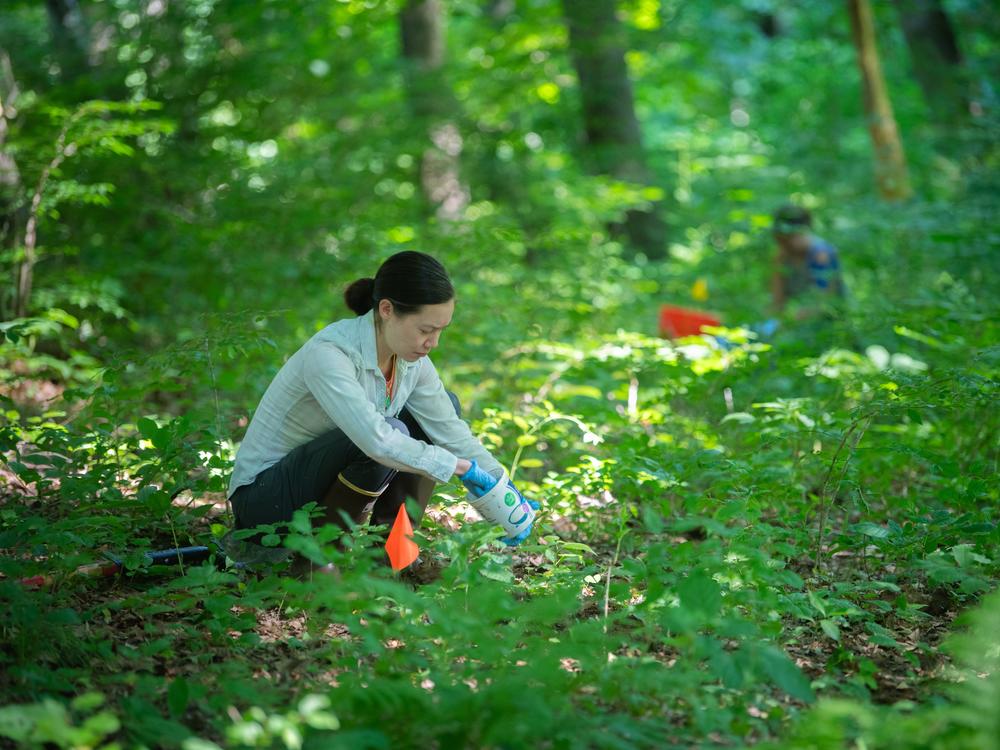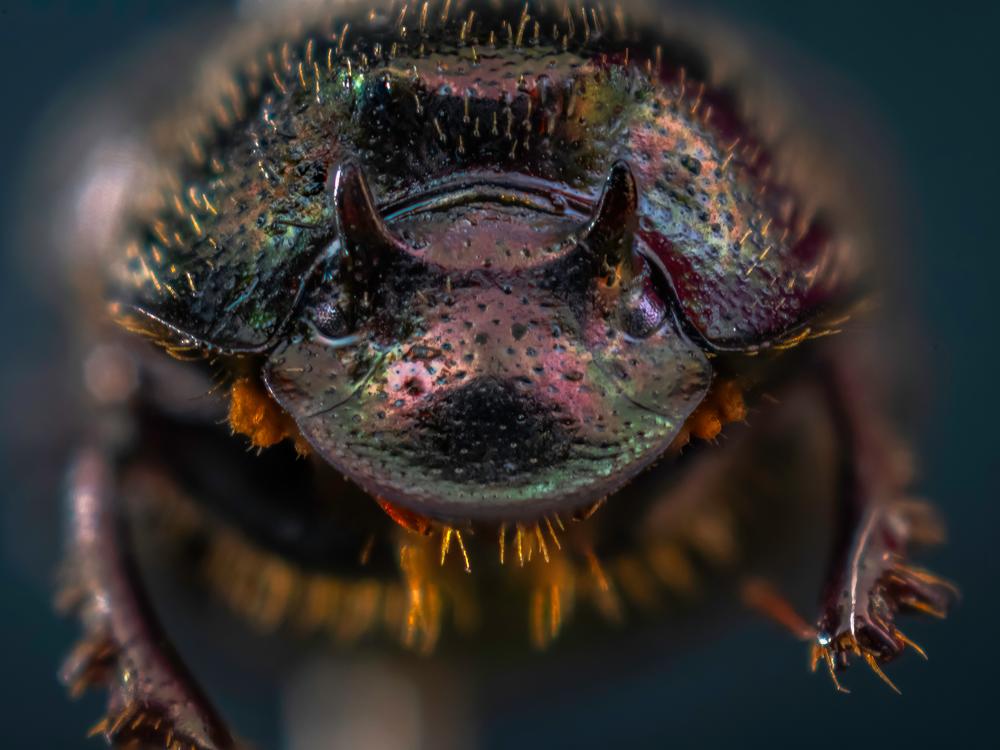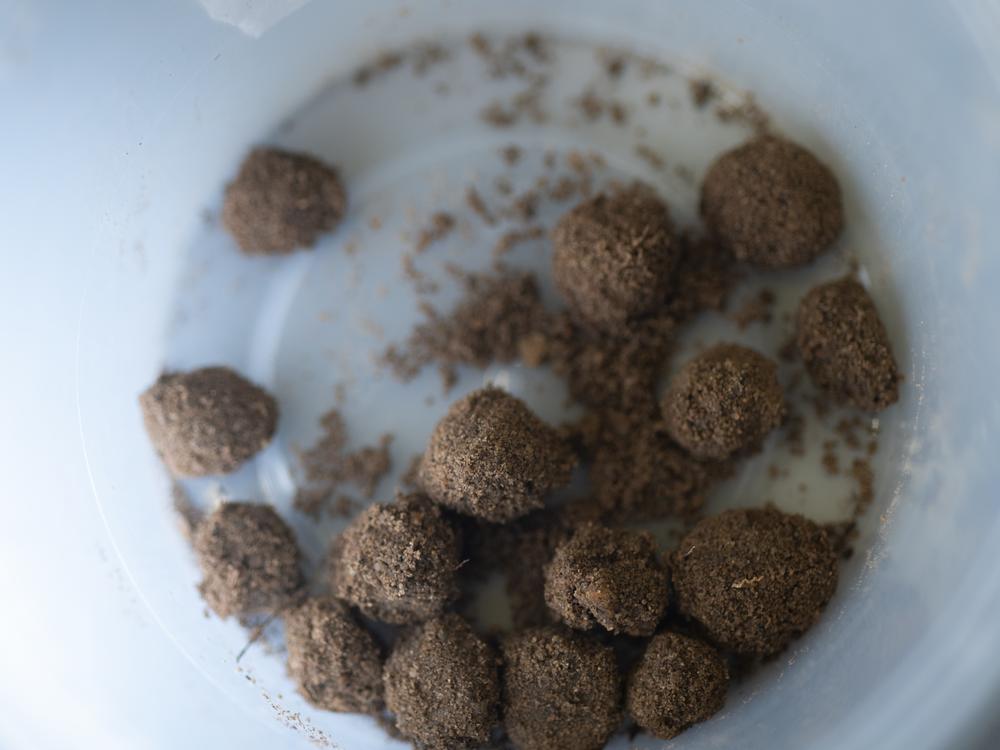Section Branding
Header Content
Searching for tiny dung beetles that clean the vast forest floor
Primary Content
On an unseasonably warm fall morning in early November, Erin McCullough strides through Hadwen Arboretum — a small patch of woodland in Worcester in central Massachusetts.
We walk through swirls of yellow maple leaves drifting to the ground. It's here on the forest floor where McCullough, a biologist at Clark University, goes on safari for organisms that have a lot to say about the health of the environments they call home.
"I have found 12 different dung beetle species [in this little patch of Worcester]," she says proudly. "I think people don't appreciate the biodiversity that's right in their backyard. Essentially, wherever there is mammal poop, there's going to be dung beetles."
McCullough has been scavenging for dung beetles twice a month since April. She found that they started to emerge in the first half of May. Their numbers peaked in July. Then, last month, she only found a few.
"I'm interested in figuring out who's here [and] how abundant they are, when do they come out," McCullough explains.
She tells me the dung beetles of the world, including those here in New England, can be divided into three broad categories. There are the rollers that roll the dung, the dwellers that hang out in the dung, "and then there are tunnelers that dig a tunnel underneath the dung pad and then bury the poop," she says.
All three types are here in Worcester but so far, McCullough has only found dwellers and tunnelers. By far, the most common species is Onthophagus orpheus, a tunneler the size of an apple seed.
"It's a really beautiful green iridescent beetle," she says. "When we're sifting through the poop, it's kind of like finding this jewel."
These jewels are more than eye candy — they're really important. "Dung beetles are nature's cleanup crew," McCullough says. "They love poop. For us, it's kind of gross. But if this is what you like, then you're just swimming in the most delicious thing ever. They build with it, they eat it, they live in it, they breed in it."
The efforts of these insects allow them to break down large amounts of animal waste, return nutrients to the soil, eliminate bacteria and other pathogens, and aerate the forest floor. In addition, in the US, dung beetles provide services — including on farmland and pastures — valued at almost six billion dollars annually.
How to trap a dung beetle
McCullough crouches down beside a trap she set out the previous day. "I have buried a Nalgene bottle so that it's flush with the ground," she says. "Then I bait it."
She baits some traps with cow dung and others, like this one, with help from her golden retriever. "I joke that every time Maggie takes a poop, she's contributing to science," McCullough says.
That science matters because dung beetles are like little windows into the health of their ecosystem, including an urban forest like this one.
"Dung beetles can be used as indicators of habitat quality," says McCullough. "So they're very sensitive to changes in environmental conditions like climate change or deforestation or habitat fragmentation."
In short, the greater the dung beetle diversity, the healthier the forest. "Everything is interconnected," she says. McCullough is also interested in the flip side — how big a forest has to be to ensure a robust dung beetle community.
McCullough turns her attention back to the Nalgene, which she pulls up out of the ground. "We go through a whole lot of gloves," she jokes.
"There's a fly in there, she says, with an edge of disappointment. "I don't really any see dung beetles."
It's possible that one is hiding in the dung, so she needs to take a closer look. For that, after gathering up the remaining traps, we head over to her lab on campus.
The beetle room
McCullough says it takes a special kind of person to sign up to work in a dung beetle lab.
Undergraduate Beatrice Altopp is one such individual. She grabs a spatula and dives in. "It looks like chocolate frosting," she says. "I like to change how I think about it!"
Charlie Fox-Whelpton has a different strategy. "I look away for about ten seconds and gather my breath and then I go back in," he says.
After 15 minutes of searching, despite the warm day, there are no dung beetles. McCullough last found them in her traps in late October, so it seems that they've gone underground for the coming winter.
Upstairs, the team has a couple dozen beetles from earlier in the season. They place one under the microscope and a little iridescent alien swims into view.
"You think of minotaurs," says Fox-Whelpton. "You think of really epic little creatures. And I think it's really cool that we find these in Massachusetts."
McCullough will resume her hunt in the spring, when the latest batch of these epic beetles find their way out onto the forest floor in search of all the fresh new waste.
Dung beetles, she says, "are maybe a little less charismatic than a monkey or a rhinoceros beetle, but I'm trying to change that."
"Maybe one day," McCullough says with a laugh, "dung beetles will get the appreciation they deserve."



